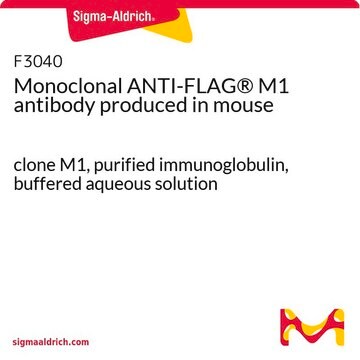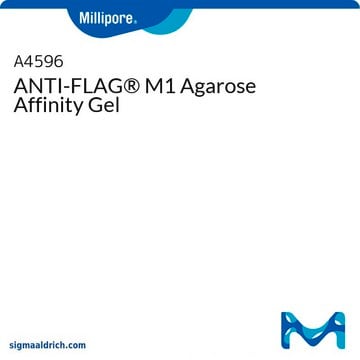F4042
Monoclonal ANTI-FLAG® M5 antibody produced in mouse
clone M5, purified immunoglobulin, buffered aqueous solution
Sinônimo(s):
Anti-ddddk, Anti-dykddddk
About This Item
Produtos recomendados
fonte biológica
mouse
conjugado
unconjugated
forma do anticorpo
purified immunoglobulin
tipo de produto de anticorpo
primary antibodies
clone
M5, monoclonal
forma
buffered aqueous solution
purificado por
using Protein A
reatividade de espécies
all
concentração
2-5 mg/mL
técnica(s)
western blot (chemiluminescent): 10 μg/mL
Isotipo
IgG1
sequência de imunogênio
DYKDDDDK
Condições de expedição
dry ice
temperatura de armazenamento
−20°C
Descrição geral
Method of purification - Protein A
Imunogênio
Aplicação
forma física
Nota de preparo
Outras notas
Informações legais
Not finding the right product?
Try our Ferramenta de seleção de produtos.
produto relacionado
Código de classe de armazenamento
12 - Non Combustible Liquids
Classe de risco de água (WGK)
nwg
Ponto de fulgor (°F)
Not applicable
Ponto de fulgor (°C)
Not applicable
Certificados de análise (COA)
Busque Certificados de análise (COA) digitando o Número do Lote do produto. Os números de lote e remessa podem ser encontrados no rótulo de um produto após a palavra “Lot” ou “Batch”.
Já possui este produto?
Encontre a documentação dos produtos que você adquiriu recentemente na biblioteca de documentos.
Os clientes também visualizaram
Nossa equipe de cientistas tem experiência em todas as áreas de pesquisa, incluindo Life Sciences, ciência de materiais, síntese química, cromatografia, química analítica e muitas outras.
Entre em contato com a assistência técnica













